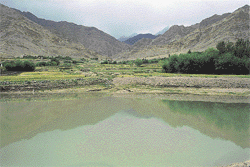LADAKH A dry future
 Retired civil engineer Chewang Norphel makes zings (small tanks fed by glacial meltwater) and artificial glaciers. The latter involves channelling glacier water to the shadow area of a mountain. He puts in half-inch-wide iron pipes along the edge of the depression where the water collects. After seeping into the pipe, the water freezes. As more water seeps in, it pushes out the frozen block, thus continuing the cycle. With this cycle continuing, a near, artificial glacier emerges on the other side.
Retired civil engineer Chewang Norphel makes zings (small tanks fed by glacial meltwater) and artificial glaciers. The latter involves channelling glacier water to the shadow area of a mountain. He puts in half-inch-wide iron pipes along the edge of the depression where the water collects. After seeping into the pipe, the water freezes. As more water seeps in, it pushes out the frozen block, thus continuing the cycle. With this cycle continuing, a near, artificial glacier emerges on the other side.
Meltwater is the only source of water for the people of Ladakh, a cold mountainous desert in Jammu and Kashmir. With an average annual rainfall of 50mm, the shortage of water poses a major problem in the area. The only source is glaciers. The melting of glaciers in summer releases the little water that the people of Ladakh use. This water is utilised by the people with utmost care. It is stored for use throughout the year. So what do receding glaciers and, in the long run, no glacier meltwater mean to them?
"The artificial glaciers will also not work. It is just a seasonal exercise. You cannot stretch it for the whole year,' says Norphel. As a matter-of-fact, he adds, "Agriculture will suffer and so will the flora and fauna. There won't be any alpine pastures left, and without that the fauna will have no fodder.' And what about groundwater? "There is a little bit of groundwater. Even if we are successful in extracting it, irrigation of land will not be possible.'
"Over the years I have noticed that the snowfall in Ladakh has decreased. If there is less snowfall and at the same time, glaciers keep thinning, there might come a time when the water will not even last for a year,' says Mohammed Deen, chief project officer, desert development programme, Leh. "It will have its impact not only on Ladakh, but the entire region
Related Content
- Ladakh Electric Vehicle and Allied Infrastructure Policy, 2022
- Budget 2013-2014: speech of P. Chidambaram, Minister of Finance
- Disaster management in flash floods in Leh (Ladakh): A case study
- The future is your choice, still
- PC clears ` 35 cr flood protection project for Leh
- Vision 2025: A Ladakh roadmap
